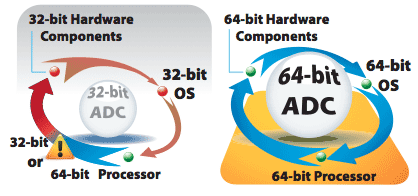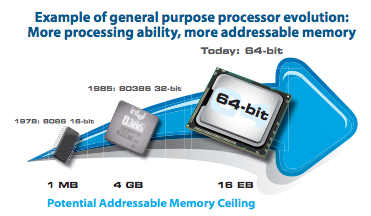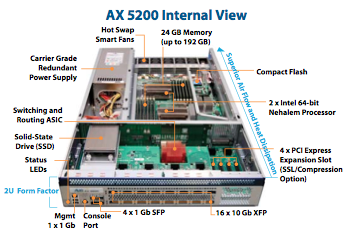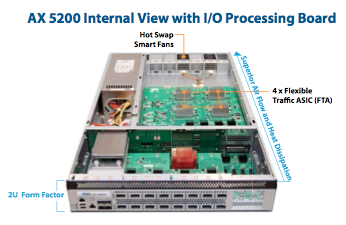
64-bit Application Delivery Controllers & 64-bit OS
Industry's First 64-bit Application Delivery Controllers and 64-bit Operating System
A10 Networks is the first to market with true 64-bit application delivery and load balancing platforms, delivering its integrated 64-bit AX Series Application Delivery Controllers (ADC) and 64-bit Advanced Core Operating System (ACOS), shipping today.
| 64-bit Advantage | ||
|---|---|---|
| Feature | Increase | Benefit |
| Maximum Memory | 6 - 48x | Most-scalable ADC |
| RAM Caching | 6x | Faster response for users |
| Concurrent Sessions | 8x | ADC consolidation, more users and headroom for growth |
| L4 Connections per Second (CPS) | 5x | ADC consolidation, more users and headroom for growth |
| Throughput | 5x | Deliver more content (large files/ high media consumption) |
| Hardware Buffers | 8x | Faster deep packet inspection/ L7 scripting, unpredicted load handling/attack mitigation and better performance over WAN links |
Note: These numbers can rise significantly due to removal of memory restrictions; numbers vary by platform selection.
While 32-bit systems have been dominant for the past couple decades, computing evolution continues to impact networking devices. 64-bit processing is the latest significant leap, increasing addressable memory to achieve the industry's highest levels of scalability and performance.
The AX Series 64-bit ADCs provide a foundation for current and future application features that need more memory or higher scalability. The impact to users and network architects is considerable: Users are delivered applications faster and seamlessly, with network architects obtaining greater efficiencies, flexibility and extensibility when deploying and managing data center applications.
Genuine 64-bit AX Series: Larger Addressable Memory for Increased Extensibility
 The AX Series is a true 64-bit ADC. ACOS, the main processors and associated hardware integrate to deliver breakthrough extensibility as a genuine 64-bit system. At its core, 64-bit refers to the ability to process data units that are 64-bits wide. Genuine 64-bit systems allow the platform, processors and operating system to process larger data values.
The AX Series is a true 64-bit ADC. ACOS, the main processors and associated hardware integrate to deliver breakthrough extensibility as a genuine 64-bit system. At its core, 64-bit refers to the ability to process data units that are 64-bits wide. Genuine 64-bit systems allow the platform, processors and operating system to process larger data values.
The most fundamental change is the removal of the 32-bit 4 GB memory limitation per core. This is critically important for a high performance ADC as features and scalability can be restrained by memory limitations in 32-bit platforms.
However, unlocking the power of 64-bit systems is not as simple as just adding a 64-bit processor. The Operating System must also be 64-bit capable, while coupled with the overall architectural design. 32-bit OSs on 64-bit capable hardware and 64-bit applications using a 32-bit kernel default to the lower common denominator of 32-bit processing. Only the genuine 64-bit AX Series with the industry's first 64-bit ACOS kernel will enable each processor thread and core to work with more than 4GB RAM.
Quantum Leap in ADC Scalability and Performance
64-bit support is now a deciding factor for any ADC deployment. As connections and corresponding demand on network devices increase, ADCs must be capable to address the required memory to support ever-increasing traffic volumes.
The additional memory within the 64-bit AX Series appliances delivers flexibility to enable additional benefits according to customer demands. Key advantages include:
- Scalable buffering
- Increased VIPs/servers
- Increased concurrent (L4/L7) sessions
- Increased SSL sessions
- Increased RAM caching
- Optimized/faster processing for aFleX TCL scripting (L7 deep packet inspection technology)
- Improved performance for concurrent feature deployment
- Improved protection for handling of unpredictable attacks or traffic spikes
- Improved WAN L7 performance
- Headroom for additional features or feature consolidation
 Breaking the 32-bit 4 GB Memory Limitation
Breaking the 32-bit 4 GB Memory Limitation
For historical perspective, the networking and security industry has been limited by 4GB RAM addressable memory. With the explosive growth of Internet traffic, processor and hardware vendors have released 64-bit capable system components to address increasing scalability demands. System vendors must provide a 64-bit kernel to overcome the bottleneck and take full advantage of 64-bit capable hardware. The AX Series platforms are the first to achieve true 64-bit Application Delivery.
64-bit architectures have a theoretical upper limit of 17.2 billion GB RAM, or 16 EB (exabyte). Breaking the 32-bit memory limitation represents unprecedented scalability for Layer 4-7 features and maximum extensibility.
The 64-bit AX Series models start with a minimum of 50% more memory than the previous systems. Today the "supercomputer class" AX 5200 starts with 600% more RAM (24 GB), and is designed to support up to 192 GB RAM.
Avoid Legacy Designs and 32-bit Limitations
With the AX Series, customers do not have to wait for the additional power of a 64-bit system. The AX Series was designed for 64-bit and no shortcuts or work arounds are in place to limit the performance. For example:
- No waiting for incumbent vendors' 32-bit OS modifications to 64-bit
- No limitation by 32-bit (non-processor) hardware
- Does not require software layers to support legacy 32-bit code
Summary
The AX Series genuine 64-bit solution (hardware platform and ACOS) improves overall ADC performance dramatically, most critically removing the memory bottleneck of 32-bit platforms. Combined with the AX Series innovative shared memory and Scalable Symmetrical Multi-Processing (SSMP) capabilities, organizations of all sizes benefit with an ADC platform for near and long-term requirements.
 |
 |
AX 5200: The industry's first genuine 64-bit ADC (platform and OS). The AX 5200 "supercomputer class" ADC employs a shared memory architecture allowing all memory to be addressed per core, delivering the most efficient memory usage on the market today.

